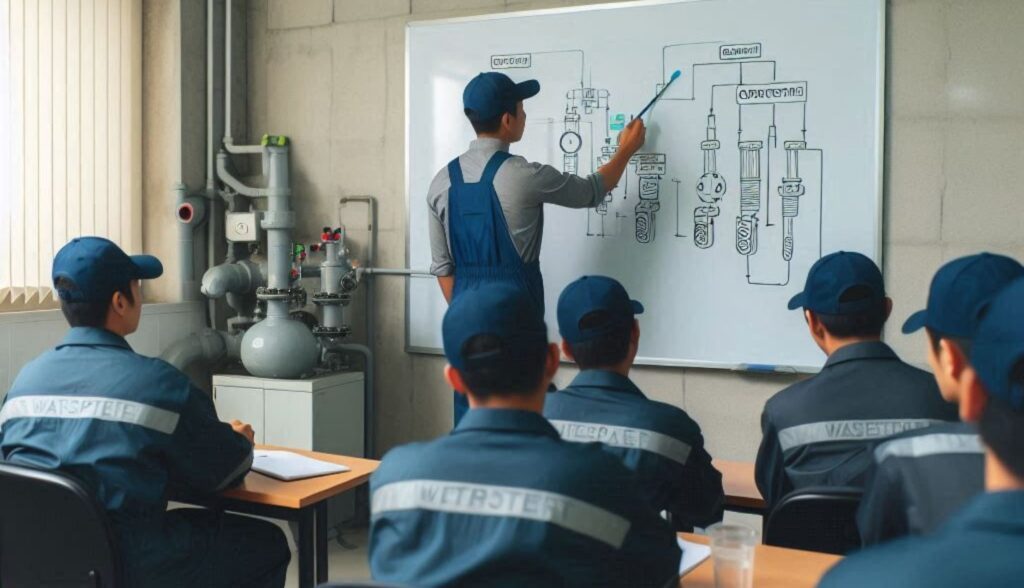Pressure head is a fundamental concept in wastewater treatment that plays a crucial role in system design, operation, and efficiency. Understanding and managing pressure head is essential for engineers, operators, and facility managers to ensure optimal treatment process performance while minimizing energy consumption and maintenance costs.

Understanding Pressure Head Fundamentals
Pressure head represents the height of a fluid column that would create the same pressure as the actual system pressure at a specific point. In wastewater treatment, this concept is crucial for designing and operating various treatment processes, from simple gravity flow systems to complex membrane filtration units.
The total head in a wastewater treatment system consists of several components:
| Component | Description | Typical Considerations |
|---|---|---|
| Static Head | Height difference between intake and discharge points | Facility topology, tank heights |
| Dynamic Head | Pressure created by fluid movement | Flow rates, pipe friction |
| Velocity Head | Kinetic energy of moving fluid | Flow velocity variations |
| Friction Head | Energy losses due to pipe friction and fittings | Pipe material, system age |
Applications in Modern Treatment Processes
Pressure head considerations affect various treatment processes differently. Understanding these applications helps optimize system performance and energy efficiency.
Pumping Systems
Lift stations and transfer pumps form the backbone of wastewater treatment facilities. Proper pressure head calculation ensures:
- Efficient pump selection and operation
- Prevention of cavitation
- Optimal energy consumption
- Reliable system performance
Membrane Systems
Modern membrane bioreactors (MBRs) and reverse osmosis systems require precise pressure head control. These systems typically operate within specific pressure ranges:
| System Type | Operating Pressure Range | Critical Considerations |
|---|---|---|
| MBR | 0.1-0.5 bar | Membrane fouling prevention |
| RO | 10-70 bar | Energy efficiency, membrane life |
| UF/MF | 0.5-3 bar | Backwash requirements |
Gravity Flow Systems
Many treatment processes rely on gravity flow, where pressure head calculations are essential for:
- Ensuring adequate flow velocities
- Preventing sediment accumulation
- Optimizing channel and pipe sizing
- Managing overflow structures
Design Considerations and Best Practices
Successful wastewater treatment system design requires careful attention to pressure head calculations and system dynamics. Key considerations include:
System Component Selection
Engineers must evaluate:
- Pump specifications and efficiency curves
- Pipe diameter and material selection
- Valve types and placement
- Instrumentation requirements
Safety Factors
Design safety factors typically account for:
- Future capacity expansion
- Equipment wear and aging
- Emergency scenarios
- Operational flexibility
Operational Efficiency and Monitoring
Modern wastewater treatment facilities employ sophisticated monitoring and control systems to optimize pressure head management:
Real-time Monitoring
Critical parameters monitored include:
- Pressure at key points
- Flow rates
- Pump performance
- Energy consumption
Control Strategies
Effective pressure head management often involves:
- Variable frequency drives (VFDs)
- Automated valve control
- Real-time system curve analysis
- Predictive maintenance scheduling
Energy Considerations and Optimization
Energy efficiency in pressure head management can significantly impact operational costs. Typical energy-saving strategies include:
| Strategy | Potential Savings | Implementation Complexity |
|---|---|---|
| VFD Installation | 20-50% | Medium |
| System Curve Optimization | 10-30% | Low |
| Smart Pump Scheduling | 15-25% | Medium |
| Regular Maintenance | 5-15% | Low |
Common Challenges and Solutions
Wastewater treatment facilities often face several pressure head-related challenges:
Challenge: Pump Cavitation
- Solution: Proper NPSH calculation and pump selection
- Prevention: Regular monitoring and maintenance
- Impact: Extended equipment life and reduced energy costs
Challenge: System Inefficiency
- Solution: Regular system curve analysis
- Prevention: Continuous monitoring and adjustment
- Impact: Optimized energy consumption and reduced operational costs
Challenge: Equipment Wear
- Solution: Predictive maintenance programs
- Prevention: Proper pressure management
- Impact: Reduced maintenance costs and improved reliability
Future Trends and Developments
The future of pressure head management in wastewater treatment is evolving with new technologies and approaches:
- Smart Systems
- AI-powered optimization
- Predictive analytics
- Remote monitoring capabilities
- Energy Recovery
- Pressure exchange devices
- Energy recovery turbines
- Heat recovery systems
- Advanced Materials
- Low-friction pipes
- Wear-resistant components
- Smart sensors and materials
Conclusion
Understanding and properly managing pressure head is crucial for the successful operation of wastewater treatment systems. As technology advances and efficiency requirements increase, the importance of optimal pressure head management will only grow. Facilities that implement comprehensive pressure head management strategies can expect:
- Reduced energy costs
- Improved system reliability
- Extended equipment life
- Better treatment performance
By following best practices in design, operation, and maintenance while embracing new technologies, wastewater treatment facilities can optimize their pressure head management and achieve superior operational results.